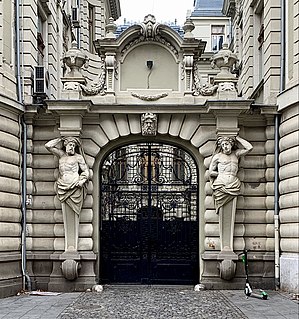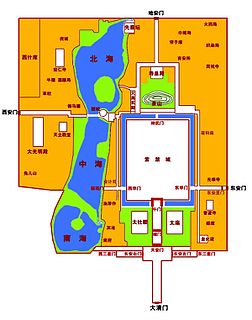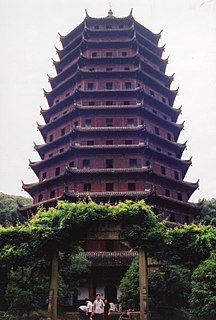This article relies largely or entirely on a single source .(March 2019) |
This article relies largely or entirely on a single source .(March 2019) |

Dates approximate

A gate or gateway is a point of entry to or from a space enclosed by walls. The word derived from old Norse "gat" meaning road or path; But other terms include yett and port. The concept originally referred to the gap or hole in the wall or fence, rather than a barrier which closed it. Gates may prevent or control the entry or exit of individuals, or they may be merely decorative. The moving part or parts of a gateway may be considered "doors", as they are fixed at one side whilst opening and closing like one.

Nineveh was an ancient Assyrian city of Upper Mesopotamia, located on the outskirts of Mosul in modern-day northern Iraq. It is located on the eastern bank of the Tigris River and was the capital and largest city of the Neo-Assyrian Empire, as well as the largest city in the world for several decades. Today, it is a common name for the half of Mosul that lies on the eastern bank of the Tigris, and the country's Nineveh Governorate takes its name from it.

Inanna is an ancient Mesopotamian goddess associated with love, beauty, sex, war, justice and political power. She was originally worshiped in Sumer under the name "Inanna", and was later worshiped by the Akkadians, Babylonians, and Assyrians under the name "Ishtar". She was known as the "Queen of Heaven" and was the patron goddess of the Eanna temple at the city of Uruk, which was her main cult center. She was associated with the planet Venus and her most prominent symbols included the lion and the eight-pointed star. Her husband was the god Dumuzid and her sukkal, or personal attendant, was the goddess Ninshubur.

The Karnak Temple Complex, commonly known as Karnak, comprises a vast mix of decayed temples, pylons, chapels, and other buildings near Luxor, Egypt. Construction at the complex began during the reign of Senusret I in the Middle Kingdom and continued into the Ptolemaic Kingdom, although most of the extant buildings date from the New Kingdom. The area around Karnak was the ancient Egyptian Ipet-isut and the main place of worship of the 18th Dynastic Theban Triad, with the god Amun as its head. It is part of the monumental city of Thebes, and in 1979 it was inscribed on the UNESCO World Heritage List along with the rest of the city. The Karnak complex gives its name to the nearby, and partly surrounded, modern village of El-Karnak, 2.5 kilometres north of Luxor.

Tōdai-ji is a Buddhist temple complex that was once one of the powerful Seven Great Temples, located in the city of Nara, Japan. Though it was originally founded in the year 738 CE, Todai-ji was not opened until the year 752 CE. The temple has undergone several reconstructions since then, with the most significant reconstruction taking place in 1709. Its Great Buddha Hall houses the world's largest bronze statue of the Buddha Vairocana, known in Japanese as Daibutsu (大仏). The temple also serves as the Japanese headquarters of the Kegon school of Buddhism. The temple is a listed UNESCO World Heritage Site as one of the "Historic Monuments of Ancient Nara", together with seven other sites including temples, shrines and places in the city of Nara.

The Ishtar Gate (Arabic: بوابة عشتار) was the eighth gate to the inner city of Babylon. It was constructed in about 575 BCE by order of King Nebuchadnezzar II on the north side of the city. It was part of a grand walled processional way leading into the city. The walls were finished in glazed bricks mostly in blue, with animals and deities in low relief at intervals, these also made up of bricks that are molded and colored differently.

Aššur (; Sumerian: 𒀭𒊹𒆠 AN.ŠAR2KI, Assyrian cuneiform: Aš-šurKI, "City of God Aššur"; Syriac: ܐܫܘܪ Āšūr; Old Persian 𐎠𐎰𐎢𐎼Aθur, Persian: آشور: Āšūr; Hebrew: אַשּׁוּר, Aššûr, Arabic: اشور), also known as Ashur and Qal'at Sherqat, was the capital of the Old Assyrian Empire (2025–1750 BC), the Middle Assyrian Empire (1365–1050 BC), and for a time, of the Neo-Assyrian Empire (911–608 BC). The remains of the city lie on the western bank of the Tigris River, north of the confluence with its tributary, the Little Zab, in what is now Iraq, more precisely in the al-Shirqat District of the Saladin Governorate.
This page provides a historical timeline of Ahmedabad, the sixth largest city in India.

Timewyrm: Genesys is an original Doctor Who novel, published by Virgin Publishing in their New Adventures range of Doctor Who novels. It was the first book in that series, and was thought of by some fans as a continuation of the television series; in effect, a Season 27 to follow the televised Season 26.

The Istanbul Archaeology Museums are a group of three archaeological museums located in the Eminönü quarter of Istanbul, Turkey, near Gülhane Park and Topkapı Palace.
Tenryū-ji (天龍寺), formally known as Tenryū Shiseizen-ji (天龍資聖禅寺), is the head temple of the Tenryū-ji branch of the Rinzai sect of Zen Buddhism, located in Susukinobaba-chō, Ukyō Ward, Kyoto, Japan. The temple was founded by Ashikaga Takauji in 1339, primarily to venerate Gautama Buddha, and its first chief priest was Musō Soseki. Construction was completed in 1345. As a temple related to both the Ashikaga family and Emperor Go-Daigo, the temple is held in high esteem, and is ranked number one among Kyoto's so-called Five Mountains. In 1994, it was registered as a UNESCO World Heritage Site, as part of the "Historic Monuments of Ancient Kyoto".

The Imperial City is a section of the city of Beijing in the Ming and Qing dynasties, with the Forbidden City at its center. It refers to the collection of gardens, shrines, and other service areas between the Forbidden City and the Inner City of ancient Beijing. The Imperial City was surrounded by a wall and accessed through seven gates and it includes historical places such as the Forbidden City, Tiananmen, Zhongnanhai, Beihai Park, Zhongshan Park, Jingshan, Imperial Ancestral Temple, and Xiancantan.
Ilu-shuma or Ilu-šūma, inscribed DINGIR-šum-ma, son of Shalim-ahum was a king of Assyria in the 20th century BC. The length of his reign is uncertain, as the Assyrian King List records him as one of the "six kings whose names were written on bricks, but whose eponyms are not known", referring to the lists of officials after which years were named.

The architecture of the Song dynasty (960–1279) was noted for its towering Buddhist pagodas, enormous stone and wooden bridges, lavish tombs, and extravagant palaces. Although literary works on architecture existed beforehand, architectural writing blossomed during the Song dynasty, maturing into a more professional form that described dimensions and working materials in a concise, organized manner. In addition to the examples still standing, depictions in Song artwork, architectural drawings, and illustrations in published books all aid modern historians in understanding the architecture of the period.

Desert God is a novel by author Wilbur Smith first published in 2014. It is part of a series of novels by Smith set to Ancient Egypt and follows the fate of the Egyptian Kingdom through the eyes of Taita, a multi-talented and highly skilled eunuch slave.

The Early Assyrian period was the earliest stage of Assyrian history, preceding the Old Assyrian period and covering the history of the city of Assur, and its people and culture, prior to the foundation of Assyria as an independent city-state under Puzur-Ashur I c. 2025 BC. Very little material and textual evidence survives from this period. The earliest archaeological evidence at Assur dates to the Early Dynastic Period, c. 2600 BC, but the city may have been founded even earlier since the area had been inhabited for thousands of years prior and other nearby cities, such as Nineveh, are significantly older.
Manzat was a Mesopotamian and Elamite goddess representing the rainbow.